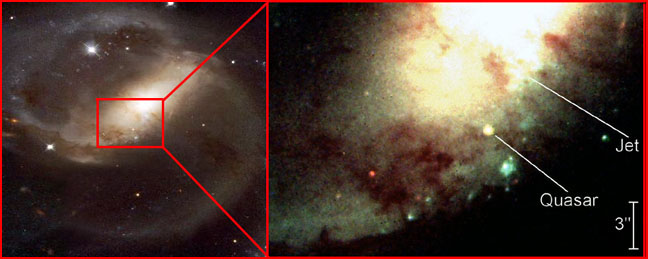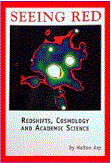|
|
||
 Credit: Jane C. Charlton (Penn State) et al., HST, ESA, NASA |
||
|
pic of the day Links:
Society for
Redshifts, Cosmology and Academic Science Order Link $25.00
|
Oct
01, 2004 October 3, 2003: the big bang was proved wrong. Again. And here is the proof (image above). The galaxy, NGC 7319, is a Seyfert 2, which means it is a galaxy shrouded with such heavy dust clouds that they obscure most of the bright, active nucleus that defines a normal Seyfert galaxy. This galaxy has a redshift of 0.0225. The tiny white spot is a quasar either silhouetted in front of the opaque gas clouds or embedded in the topmost layers of the dust. The redshift of the quasar is 2.114. Why does this prove the big bang wrong? One of the two major foundations of the big bang is that redshift is proportional to distance. That means the larger the redshift of an object, the farther away it must be. The other major foundation of the big bang is that all redshift is a measure of velocity. Again, the larger the redshift of an object, the faster it is moving away from us. Combined, these two foundations become the expanding universe, which can be traced backwards to the big bang. Look at the picture again. By the big bang principles, this quasar must be billions of light years farther from us than the galaxy, because its redshift is so much larger. And yet the galaxy is opaque, so the quasar must be near the surface of the dust clouds or even in front of them. Pasquale Galianni, Margaret Burbidge, Halton Arp, V. Junkkarinen, Geoffrey Burbidge, and Stefano Zibetti, the astronomers who wrote the paper describing this discovery, also studied the dust clouds surrounding the quasar. There's a bright triangular jet (see insert above) with its fat end on the galaxy nucleus and thin end pointing at the quasar. Radio, x-ray and spectra observations show that this area is disturbed. These gasses are more turbulent than the gasses in other regions of the galaxy. That seems to indicate that something big and powerful has passed through, moving outward from the nucleus. In addition to the jet, the region of the galaxy near the quasar is glowing with an excess of low-density emission lines from ionized gasses. But nothing is "there" to light them up except the impossible quasar. This is not the first definitive disproof of the redshift = distance principle, although it may be the best to date. Halton Arp has been accumulating discordant redshift evidence since the late 1960's. His most recent tactic has been to look at the objects called ULX's (the quasar above is one of them). ULX stands for Ultra Luminous X-ray sources, which are tiny concentrations of x-rays in or very near an active galaxy. The x-ray concentration is stronger than any known astronomical object, even a supernova, can produce. Over the last two years, Arp has shown that at least 20 of these objects are quasars, with redshifts much higher than the galaxy they are associated with. The example seen above is the closest pair of the 20. About the new observations, one cosmologist said, "If astronomy were a science, this paper would mean the end of the big bang." Instead, the paper was scarcely noted when it was presented to the American Astronomical Society meeting in January 2004. When submitted to an astronomical journal, heavy editing was recommended by the peer review committee. And now it sits with the editor, awaiting permission for publication. And waiting. And waiting. It's time for set-in-their-way astronomers (of any age) to pack away their big bang assumptions and retire. And it's time for pioneering astronomers to discover new relationships between galaxies and quasars. This will mean a whole new universe to explore, with all the excitement and uncertainty of "cosmos incognito". The shape, the size, and the age of the universe must be discovered anew. The new observations are filled with clues about how galaxies are born; how they grow; even how they die. It's a great opportunity for those who view astronomy as an adventure in discovery rather than as a competition for funding. [See Arp's lecture video, "Intrinsic Redshift," for more details of this new picture of the universe.] Available from Mikamar Publishing |
|
|
Copyright 2004: thunderbolts.info |
||

